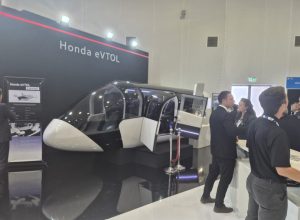
Honda has given more details of its eVTOL concept at the show. The company is displaying a cabin mock-up of its hybrid-electric-powered eVTOL, which is still in the early development phase. According to company representatives at the event, the new aircraft is unlikely to enter the market this decade, as the infrastructure to support its scalable operations is not yet in place. Developing this infrastructure will also be an integral part of its low altitude transport concept.
“Honda aims to build a mobility ecosystem that greatly expands the freedom of mobility for people by providing services that link mobility in the skies with all types of ground-based mobility products and services, not only Honda products but also public transportation systems,” said the company in a new eVTOL section of its website. “By integrating various elements such as reservation systems, infrastructure, flight operation and air traffic control systems, and various types of mobility products, the system will become capable of offering a variety of recommendations such as the shortest route achieved through the seamless links among various mobility products/services on the ground and in the skies.”

The Honda eVTOL is equipped with eight rotors for vertical take-off and landing and two rotors for propulsion. It features a gas turbine hybrid power unit which will give the aircraft a range of 400 km. “Honda is the only company in the world that has obtained U.S. Federal Aviation Administration (FAA) certification for both the airframe and the aircraft engine, conducting HondaJet business,” said the company website. “Our know-how in the FAA certification process will enable us to increase the efficiency of eVTOL development and speed up the delivery of Honda eVTOL to our customers. Moreover, Honda will make a great use of its expertise in lightweight structures and production technologies unique only to aircraft.”
“F1™ technologies, both tangible and intangible, have also been incorporated into the development of Honda eVTOL, including F1™ power unit technology applied for the ultra-high rpm generator, as well as the simulation analysis technology and facilities for aerodynamic development. Racing chassis technologies are also applied to Honda eVTOL as there are many similarities in aerodynamic phenomena because the speed range and airflow turbulence eVTOL needs to manage are closer to those of F1™ machines than of passenger airplanes. Moreover, Honda also has time-proven hybrid technologies as well as safety technologies such as Honda SENSING technologies. Participation of Honda engineers with experience in various areas including HondaJet, F1™, hybrid vehicles and safety and driver-assistive technologies, is enabling the project team to pursue the development of eVTOL unique only to Honda.”
For more information
https://global.honda/en/tech/Electric_Vertical_Take-Off_and_Landing_aircraft_eVTOL

